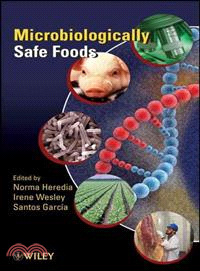Microbiologically Safe Foods
商品資訊
ISBN13:9780470053331
出版社:John Wiley & Sons Inc
作者:Heredia
出版日:2009/04/02
裝訂/頁數:精裝/696頁
定價
:NT$ 7370 元優惠價
:90 折 6633 元
若需訂購本書,請電洽客服 02-25006600[分機130、131]。
商品簡介
作者簡介
名人/編輯推薦
目次
相關商品
商品簡介
This book focuses on state of the art technologies to produce microbiologically safe foods for our global dinner table. Each chapter summarizes the most recent scientific advances, particularly with respect to food processing, pre- and post-harvest food safety, quality control, and regulatory information.
The book begins with a general discussion of microbial hazards and their public health ramifications. It then moves on to survey the production processes of different food types, including dairy, eggs, beef, poultry, and fruits and vegetables, pinpointing potential sources of human foodborne diseases. The authors address the growing market in processed foods as well novel interventions such as innovative food packaging and technologies to reduce spoilage organisms and prolong shelf life. Each chapter also describes the ormal flora of raw product, spoilage issues, pathogens of concern, sources of contamination, factors that influence survival and growth of pathogens and spoilage organisms, indicator microorganisms, approaches to maintaining product quailty and reducing harmful microbial populations, microbial standards for end-product testing, conventional microbiological and molecular methods, and regulatory issues.
Other important topics include the safety of genetically modified organisms (GMOs), predictive microbiology, emerging foodborne pathogens, good agricultural and manufacturing processes, avian influenza, and bioterrorism.
The book begins with a general discussion of microbial hazards and their public health ramifications. It then moves on to survey the production processes of different food types, including dairy, eggs, beef, poultry, and fruits and vegetables, pinpointing potential sources of human foodborne diseases. The authors address the growing market in processed foods as well novel interventions such as innovative food packaging and technologies to reduce spoilage organisms and prolong shelf life. Each chapter also describes the ormal flora of raw product, spoilage issues, pathogens of concern, sources of contamination, factors that influence survival and growth of pathogens and spoilage organisms, indicator microorganisms, approaches to maintaining product quailty and reducing harmful microbial populations, microbial standards for end-product testing, conventional microbiological and molecular methods, and regulatory issues.
Other important topics include the safety of genetically modified organisms (GMOs), predictive microbiology, emerging foodborne pathogens, good agricultural and manufacturing processes, avian influenza, and bioterrorism.
作者簡介
Norma Heredia, ScD, is Professor of Food Safety at the University of Nuevo Leon in Mexico. Her research focus is the epidemiology and control of microorganisms in foods. She serves the industry and government as a consultant and in laboratory analysis of food microbiology. She has served on the editorial boards and as an ad hoc reviewer for several journals.
Irene Wesley, DPH, is a microbiologist at the National Animal Disease Center, part of the USDA's Agricultural Research Service, in Ames, Iowa. Her research focus is the on-farm detection of microbial foodborne pathogens in livestock and poultry. She is a member of the American Academy of Microbiology and has served on national food safety committees and editorial boards.
Santos Garcia, ScD, is Professor and Consultant of Food Safety at the University of Nuevo Leon in Mexico. His research focus is the physiology and control of microbial food-borne pathogens. He has served on international food safety committees and editorial boards for several journals. He is a coeditor of Guide to Foodborne Pathogens (Wiley).
Irene Wesley, DPH, is a microbiologist at the National Animal Disease Center, part of the USDA's Agricultural Research Service, in Ames, Iowa. Her research focus is the on-farm detection of microbial foodborne pathogens in livestock and poultry. She is a member of the American Academy of Microbiology and has served on national food safety committees and editorial boards.
Santos Garcia, ScD, is Professor and Consultant of Food Safety at the University of Nuevo Leon in Mexico. His research focus is the physiology and control of microbial food-borne pathogens. He has served on international food safety committees and editorial boards for several journals. He is a coeditor of Guide to Foodborne Pathogens (Wiley).
名人/編輯推薦
"This book discusses the microbiologicai quality and safety of foods, with particular reference to novel processing techniques for ensuring food safety." (Food Science and Technology Abstracts, July 2010)
“This book focuses on state-of the-art technologies to produce microbiologically safe foods for our dinner table.” (Chemistry World, October 2009)
“This book focuses on state-of the-art technologies to produce microbiologically safe foods for our dinner table.” (Chemistry World, October 2009)
目次
CONTRIBUTORS.
FOREWORD.
PREFACE.
I MICROBIAL FOOD HAZARDS.
1 PUBLIC HEALTH IMPACT OF FOODBORNE ILLNESS: IMPETUS FOR THE INTERNATIONAL FOOD SAFETY EFFORT (Irene V. Wesley).
1.1 Introduction.
1.2 Statistical Estimates.
1.3 Impact of Representative Foodborne Pathogens.
1.4 National Microbial Baseline Surveys.
1.5 Global Marketplace.
References.
2 FOODBORNE PATHOGENS AND TOXINS: AN OVERVIEW (Santos Garcia and Norma Heredia).
2.1 Introduction.
2.2 Aeromonas.
2.3 Arcobacter.
2.4 Bacillus cereus.
2.5 Brucella.
2.6 Campylobacter.
2.7 Clostridium botulinum.
2.8 Clostridium perfringens.
2.9 Escherichia coli.
2.10 Listeria.
2.11 Plesiomonas shigelloides.
2.12 Salmonella.
2.13 Shigella.
2.14 Staphylococcus aureus.
2.15 Vibrio.
2.16 Yersinia.
2.17 Mycotoxins and Fungi.
2.18 Cryptosporidium.
2.19 Cyclospora.
2.20 Entamoeba.
2.21 Giardia.
2.22 Anisakis simplex.
2.23 Ascaris.
2.24 Diphyllobothrium latum.
2.25 Taenia.
2.26 Trichinella spiralis.
2.27 Hepatitis A and E Viruses.
2.28 Norovirus.
References.
II EMERGING ISSUES.
3 CRONOBACTER GEN. NOV. (ENTEROBACTER) SAKAZAKII: CURRENT KNOWLEDGE AND FUTURE CONSIDERATIONS (Genisis Iris Dancer and Dong-Hyun Kang).
3.1 Introduction.
3.2 History of Illness Caused by (E). sakazakii.
3.3 Infant Susceptibility.
3.4 Novel Prevention Strategies.
3.5 Infant Formula Processing.
3.6 Biochemical Characterization and Taxonomy.
3.7 Environmental Sources of (E). sakazakii.
3.8 Resistance and Virulence Factors of (E). sakazakii.
3.9 Current Isolation and Detection Techniques.
References.
4 PRION DISEASES (Debbie McKenzie and Judd Aiken).
4.1 Introduction.
4.2 Transmissible Spongiform Encephalopathies.
4.3 Nature of the Illness Caused.
4.4 Pathogenesis.
4.5 Characteristics of the Agent.
4.6 Epidemiology.
4.7 PrPSc Detection.
4.8 Physical Means of Destruction of the Organism.
4.9 Prevention and Control Measures.
References.
5 AVIAN INFLUENZA A (H5N1): POTENTIAL THREAT TO FOOD SAFETY (James Mark Simmerman and Peter K. Ben Embarek).
5.1 Introduction.
5.2 Emergence of H5N1 Avian Influenza.
5.3 Epidemiology of Human H5N1 Infection.
5.4 Clinical Presentation and Laboratory Diagnosis.
5.5 Food Safety Considerations.
5.6 Global Response.
References.
III FOOD SAFETY ISSUES AND THE MICROBIOLOGY OF SPECIFIC COMMODITIES.
6 FOOD SAFETY ISSUES AND THE MICROBIOLOGY OF BEEF (Robin C. Anderson, Steven C. Ricke, Bwalya Lungu, Michael G. Johnson, Christy Oliver, Shane M. Horrocks, and David J. Nisbet).
6.1 Introduction.
6.2 Enterohemorrhagic Escherichia coli O157:H7 in Beef.
6.3 Salmonella in Beef.
6.4 Listeria in Beef.
6.5 Campylobacter in Beef.
6.6 Control of Foodborne Pathogens in Beef.
6.7 Conclusions.
References.
7 FOOD SAFETY ISSUES AND THE MICROBIOLOGY OF MILK AND DAIRY PRODUCTS (Mansel W. Griffiths).
7.1 Introduction.
7.2 Microflora of Raw Milk.
7.3 Public Health Concerns from Dairy Products.
7.4 Milk and Cream.
7.5 Cheese and Fermented Dairy Products.
7.6 Ice Cream.
7.7 Butter.
7.8 Milk Powder.
7.9 Detection of Microorganisms in Milk.
7.10 Novel Processing Methods.
7.11 Global Trade and Regulations.
References.
8 FOOD SAFETY ISSUES AND THE MICROBIOLOGY OF POULTRY (Irene V. Wesley).
8.1 Introduction.
8.2 Characteristics of Foodborne Illness.
8.3 Approaches to Maintaining Product Quality and Reducing the Number of Microorganisms.
8.4 Conclusions.
References.
9 FOOD SAFETY ISSUES AND THE MICROBIOLOGY OF EGGS AND EGG PRODUCTS (Jean-Yves D’Aoust).
9.1 Shell Egg Development and Structure.
9.2 Microflora of Shell Eggs.
9.3 Significance of the Detection of Salmonella.
9.4 Eggborne Outbreaks of Human Salmonellosis.
9.5 Thermal Processing of Egg Products.
9.6 Potentially Hazardous Egg Products in the Home.
9.7 Control.
References.
10 FOOD SAFETY ISSUES AND THE MICROBIOLOGY OF PORK (Gay Y. Miller and James S. Dickson).
10.1 Introduction.
10.2 Normal Flora of Raw Pork.
10.3 Spoilage.
10.4 Pathogens of Concern.
10.5 Risk of Contamination During Processing.
10.6 Survival and Growth of Pathogens and Spoilage Organisms in Pork Products.
10.7 Indicator Microorganisms.
10.8 Maintaining Product Quality and Reducing the Number of Microorganisms.
10.9 Microbiological Methods for Detection and Quantification.
10.10 Regulations.
References.
11 FOOD SAFETY ISSUES AND THE MICROBIOLOGY OF FISH AND SHELLFISH (Lucio Galaviz-Silva, Gracia Gomez-Anduro, Zinnia J. Molina-Garza, and Felipe Ascencio-Valle).
11.1 Introduction.
11.2 Normal Flora of Fish and Shellfish.
11.3 Microbial Hazards and Preventive Measures.
11.4 Spoilage.
11.5 Seafood Processing and Food Safety.
11.6 Product Quality and Microorganism Reduction Methods.
11.7 Microbiological Methods for Detection and Quantification of Seafood Pathogens.
11.8 Food Safety Challenges for Aquaculture and the Commercial Fishing Industry.
11.9 Effects of Climate on Waterborne and Foodborne Seafood Pathogens.
11.10 Conclusions.
References.
12 FOOD SAFETY ISSUES AND THE MICROBIOLOGY OF FRUITS AND VEGETABLES (Juan S. Leon, Lee-Ann Jaykus, and Christine L. Moe).
12.1 Introduction.
12.2 Normal Microflora of Fresh Produce.
12.3 Spoilage of Fresh Produce.
12.4 Human Pathogens Associated with Produce.
12.5 Factors that Influence Survival and Growth of Organisms.
12.6 Microbiological Methods for Detection and Quantification.
12.7 Indicator Microorganisms.
12.8 Sources of Produce Contamination.
12.9 Maintaining Produce Quality and Reducing the Number of Microorganisms.
12.10 Regulations.
12.11 Conclusions.
References.
13 FOOD SAFETY ISSUES AND THE MICROBIOLOGY OF FRUIT BEVERAGES AND BOTTLED WATER (Mickey E. Parish).
13.1 Introduction.
13.2 Normal Microflora.
13.3 Spoilage.
13.4 Pathogens.
13.5 Maintaining Product Quality and Reducing Microbial Numbers.
13.6 U.S. Regulations.
References.
14 FOOD SAFETY ISSUES AND THE MICROBIOLOGY OF CANNED AND FROZEN FOODS (Nina G. Parkinson).
14.1 Introduction.
14.2 History of Canned Foods.
14.3 Categories of Canned Foods.
14.4 Safety of Canned Foods.
14.5 Microbial Spoilage of Canned Foods.
14.6 History of Frozen Foods.
14.7 Principles of Frozen Food Preservation.
14.8 Safety and Spoilage of Frozen Foods.
14.9 U.S. Regulations.
References.
15 FOOD SAFETY ISSUES AND THE MICROBIOLOGY OF CEREALS AND CEREAL PRODUCTS (Lloyd B. Bullerman and Andreia Bianchini).
15.1 Introduction.
15.2 Health Implications of Fungal Deterioration of Grains.
15.3 Mycotoxins.
15.4 Media and Methods for Molds and Mycotoxins.
References.
16 FOOD SAFETY ISSUES AND THE MICROBIOLOGY OF SPICES AND HERBS (Keith A. Ito).
16.1 Introduction.
16.2 Use of Spices and Herbs in Foods.
16.3 Antimicrobial Effects.
16.4 Contamination of Spices and Herbs.
16.5 Recalls and Outbreaks.
16.6 Control Procedures.
16.7 Conclusions.
References.
17 FOOD SAFETY ISSUES AND THE MICROBIOLOGY OF MAYONNAISE, SALAD DRESSINGS, ACIDIC CONDIMENTS, AND MAYONNAISE-BASED SALADS (Larry R. Beuchat).
17.1 Introduction.
17.2 Mayonnaise.
17.3 Salad Dressings and Sauces.
17.4 Acidic Condiments.
17.5 Salads, Sandwiches, and Other Ready-to-Eat Foods Containing Mayonnaise and Acidic Condiments.
References.
18 FOOD SAFETY ISSUES AND THE MICROBIOLOGY OF CHOCOLATE AND SWEETENERS (Norma Heredia and Santos Garcia).
18.1 Introduction.
18.2 Normal Flora of Raw and Fermented Cocoa Beans.
18.3 Spoilage and Shelf Life of Chocolate.
18.4 Pathogens in Confectionery Products.
18.5 Sources of Contamination.
18.6 Factors that Influence Survival and Growth of Pathogens and Spoilage Organisms.
18.7 Maintaining Product Quality and Reducing Microbial Numbers.
18.8 Microbiological Methods for Detection and Quantification.
18.9 Regulations.
References.
IV PREVENTION AND CONTROL STRATEGIES.
19 MICROBIAL RISK ASSESSMENT (Marianne D. Miliotis and Robert L. Buchanan).
19.1 Introduction.
19.2 Risk Assessment Framework.
19.3 Risk Assessment Analytical Tools.
19.4 Qualitative vs. Quantitative Risk Assessments.
19.5 Types of Risk Assessment.
19.6 Predictive Microbiology.
19.7 Using Risk Assessment to Make Risk Management Decisions.
References.
20 GOOD MANUFACTURING PRACTICES (Olga I. Padilla-Zakour).
20.1 Introduction.
20.2 Personnel.
20.3 Buildings and Facilities.
20.4 Sanitation.
20.5 Pest Control.
20.6 Equipment.
20.7 Operations.
20.8 Warehousing and Distribution.
20.9 Sanitation Standard Operating Procedures.
References.
21 CLEANING AND SANITIZING OPERATIONS (Kevin Keener).
21.1 Introduction.
21.2 Food Sanitation.
21.3 Food Regulations.
21.4 Sanitation Programs.
21.5 Sanitation Program Development.
21.6 Crisis Management: How to Survive a Recall.
21.7 Educational and Training Resources.
References.
22 HAZARD ANALYSIS OF CRITICAL CONTROL POINTS (Martin W. Bucknavage and Catherine Nettles Cutter).
22.1 Introduction.
22.2 HACCP Fundamentals.
22.3 Conclusions.
References.
23 TRADITIONAL AND HIGH-TECHNOLOGY APPROACHES TO MICROBIAL SAFETY IN FOODS (Tatiana Koutchma).
23.1 Introduction.
23.2 Thermal vs. Nonthermal Technology.
23.3 Establishment of Specifications for Preservation.
23.4 Technologies Based on Thermal Effects.
23.5 Technologies Based on Nonthermal Effects.
23.6 Conclusions.
References.
24 FOOD PRESERVATION TECHNIQUES OTHER THAN HEAT AND IRRADIATION (Ronald G. Labbe and Linda L. Nolan).
24.1 Introduction.
24.2 Traditional Physical Methods of Food Preservation.
24.3 Food Antimicrobials.
24.4 Preservatives from Biological Sources.
24.5 Hurdle Technology.
References.
25 FOOD SAFETY AND INNOVATIVE FOOD PACKAGING (Jung (John H. Han).
25.1 Introduction.
25.2 Innovative Packaging to Enhance Food Safety.
25.3 Conclusions.
References.
V DETECTION OF FOODBORNE PATHOGENS.
26 TRADITIONAL METHODS FOR DETECTION OF FOODBORNE PATHOGENS (Luisa Solıs, Eduardo Sanchez, Santos Garcıa, and Norma Heredia).
26.1 Introduction.
26.2 General Quantification Methods.
26.3 Quantification and Detection Methods for Specific Microorganisms.
References.
27 RAPID METHODS FOR FOODBORNE BACTERIAL ENUMERATION AND PATHOGEN DETECTION (Peter Feng and Norma Heredia).
27.1 Introduction.
27.2 Logistics of Food Testing.
27.3 Rapid Pathogen Testing Methods.
27.4 Rapid Enumeration Methods.
27.5 Logistics, Resources, and Applicability.
References.
28 LABORATORY ACCREDITATION AND PROFICIENCY TESTING (DeAnn L. Benesh).
28.1 Introduction.
28.2 Laboratory Accreditation.
28.3 Proficiency Testing.
28.4 Global Perspectives.
References.
VI CURRENT AND FUTURE ISSUES IN FOOD SAFETY.
29 BIOTERRORISM AND FOOD SAFETY (Barbara. A. Rasco and Gleyn E. Bledsoe).
29.1 Introduction.
29.2 The Need for Protective Food Security Programs.
29.3 Vulnerability Assessment.
29.4 Emergency Response and Product Recovery.
29.5 Prevention as the First Line of Defense.
29.6 Development of a Food Security Plan Based on HACCP Principles.
29.7 Evaluating Security Risks and Identifying Hazards.
29.8 Managing Risk: Preventive Measures.
29.9 Security Strategies.
Appendix: An Example.
References.
30 PREDICTIVE MICROBIOLOGY: GROWTH IN SILICO (Mark L. Tamplin).
30.1 Introduction.
30.2 Applications of Predictive Microbiology in the Food Industry.
30.3 Models.
30.4 Tools in Predictive Microbiology.
30.5 Databases to Support Predictive Microbiology.
30.6 Conclusions.
References.
31 ROLE OF GENETICALLY MODIFIED ORGANISMS IN FOOD SAFETY (Fidel Guevara-Lara).
31.1 Introduction .
31.2 Genetically Modified Foods in the World Market.
31.3 Potential of GMOs to Increase Food Safety.
31.4 Increased Safety of GMOs for the Environment and Human Health.
31.5 Food Safety Issues and Public Concerns Regarding GMOs.
31.6 Conclusions.
References.
INDEX.
FOREWORD.
PREFACE.
I MICROBIAL FOOD HAZARDS.
1 PUBLIC HEALTH IMPACT OF FOODBORNE ILLNESS: IMPETUS FOR THE INTERNATIONAL FOOD SAFETY EFFORT (Irene V. Wesley).
1.1 Introduction.
1.2 Statistical Estimates.
1.3 Impact of Representative Foodborne Pathogens.
1.4 National Microbial Baseline Surveys.
1.5 Global Marketplace.
References.
2 FOODBORNE PATHOGENS AND TOXINS: AN OVERVIEW (Santos Garcia and Norma Heredia).
2.1 Introduction.
2.2 Aeromonas.
2.3 Arcobacter.
2.4 Bacillus cereus.
2.5 Brucella.
2.6 Campylobacter.
2.7 Clostridium botulinum.
2.8 Clostridium perfringens.
2.9 Escherichia coli.
2.10 Listeria.
2.11 Plesiomonas shigelloides.
2.12 Salmonella.
2.13 Shigella.
2.14 Staphylococcus aureus.
2.15 Vibrio.
2.16 Yersinia.
2.17 Mycotoxins and Fungi.
2.18 Cryptosporidium.
2.19 Cyclospora.
2.20 Entamoeba.
2.21 Giardia.
2.22 Anisakis simplex.
2.23 Ascaris.
2.24 Diphyllobothrium latum.
2.25 Taenia.
2.26 Trichinella spiralis.
2.27 Hepatitis A and E Viruses.
2.28 Norovirus.
References.
II EMERGING ISSUES.
3 CRONOBACTER GEN. NOV. (ENTEROBACTER) SAKAZAKII: CURRENT KNOWLEDGE AND FUTURE CONSIDERATIONS (Genisis Iris Dancer and Dong-Hyun Kang).
3.1 Introduction.
3.2 History of Illness Caused by (E). sakazakii.
3.3 Infant Susceptibility.
3.4 Novel Prevention Strategies.
3.5 Infant Formula Processing.
3.6 Biochemical Characterization and Taxonomy.
3.7 Environmental Sources of (E). sakazakii.
3.8 Resistance and Virulence Factors of (E). sakazakii.
3.9 Current Isolation and Detection Techniques.
References.
4 PRION DISEASES (Debbie McKenzie and Judd Aiken).
4.1 Introduction.
4.2 Transmissible Spongiform Encephalopathies.
4.3 Nature of the Illness Caused.
4.4 Pathogenesis.
4.5 Characteristics of the Agent.
4.6 Epidemiology.
4.7 PrPSc Detection.
4.8 Physical Means of Destruction of the Organism.
4.9 Prevention and Control Measures.
References.
5 AVIAN INFLUENZA A (H5N1): POTENTIAL THREAT TO FOOD SAFETY (James Mark Simmerman and Peter K. Ben Embarek).
5.1 Introduction.
5.2 Emergence of H5N1 Avian Influenza.
5.3 Epidemiology of Human H5N1 Infection.
5.4 Clinical Presentation and Laboratory Diagnosis.
5.5 Food Safety Considerations.
5.6 Global Response.
References.
III FOOD SAFETY ISSUES AND THE MICROBIOLOGY OF SPECIFIC COMMODITIES.
6 FOOD SAFETY ISSUES AND THE MICROBIOLOGY OF BEEF (Robin C. Anderson, Steven C. Ricke, Bwalya Lungu, Michael G. Johnson, Christy Oliver, Shane M. Horrocks, and David J. Nisbet).
6.1 Introduction.
6.2 Enterohemorrhagic Escherichia coli O157:H7 in Beef.
6.3 Salmonella in Beef.
6.4 Listeria in Beef.
6.5 Campylobacter in Beef.
6.6 Control of Foodborne Pathogens in Beef.
6.7 Conclusions.
References.
7 FOOD SAFETY ISSUES AND THE MICROBIOLOGY OF MILK AND DAIRY PRODUCTS (Mansel W. Griffiths).
7.1 Introduction.
7.2 Microflora of Raw Milk.
7.3 Public Health Concerns from Dairy Products.
7.4 Milk and Cream.
7.5 Cheese and Fermented Dairy Products.
7.6 Ice Cream.
7.7 Butter.
7.8 Milk Powder.
7.9 Detection of Microorganisms in Milk.
7.10 Novel Processing Methods.
7.11 Global Trade and Regulations.
References.
8 FOOD SAFETY ISSUES AND THE MICROBIOLOGY OF POULTRY (Irene V. Wesley).
8.1 Introduction.
8.2 Characteristics of Foodborne Illness.
8.3 Approaches to Maintaining Product Quality and Reducing the Number of Microorganisms.
8.4 Conclusions.
References.
9 FOOD SAFETY ISSUES AND THE MICROBIOLOGY OF EGGS AND EGG PRODUCTS (Jean-Yves D’Aoust).
9.1 Shell Egg Development and Structure.
9.2 Microflora of Shell Eggs.
9.3 Significance of the Detection of Salmonella.
9.4 Eggborne Outbreaks of Human Salmonellosis.
9.5 Thermal Processing of Egg Products.
9.6 Potentially Hazardous Egg Products in the Home.
9.7 Control.
References.
10 FOOD SAFETY ISSUES AND THE MICROBIOLOGY OF PORK (Gay Y. Miller and James S. Dickson).
10.1 Introduction.
10.2 Normal Flora of Raw Pork.
10.3 Spoilage.
10.4 Pathogens of Concern.
10.5 Risk of Contamination During Processing.
10.6 Survival and Growth of Pathogens and Spoilage Organisms in Pork Products.
10.7 Indicator Microorganisms.
10.8 Maintaining Product Quality and Reducing the Number of Microorganisms.
10.9 Microbiological Methods for Detection and Quantification.
10.10 Regulations.
References.
11 FOOD SAFETY ISSUES AND THE MICROBIOLOGY OF FISH AND SHELLFISH (Lucio Galaviz-Silva, Gracia Gomez-Anduro, Zinnia J. Molina-Garza, and Felipe Ascencio-Valle).
11.1 Introduction.
11.2 Normal Flora of Fish and Shellfish.
11.3 Microbial Hazards and Preventive Measures.
11.4 Spoilage.
11.5 Seafood Processing and Food Safety.
11.6 Product Quality and Microorganism Reduction Methods.
11.7 Microbiological Methods for Detection and Quantification of Seafood Pathogens.
11.8 Food Safety Challenges for Aquaculture and the Commercial Fishing Industry.
11.9 Effects of Climate on Waterborne and Foodborne Seafood Pathogens.
11.10 Conclusions.
References.
12 FOOD SAFETY ISSUES AND THE MICROBIOLOGY OF FRUITS AND VEGETABLES (Juan S. Leon, Lee-Ann Jaykus, and Christine L. Moe).
12.1 Introduction.
12.2 Normal Microflora of Fresh Produce.
12.3 Spoilage of Fresh Produce.
12.4 Human Pathogens Associated with Produce.
12.5 Factors that Influence Survival and Growth of Organisms.
12.6 Microbiological Methods for Detection and Quantification.
12.7 Indicator Microorganisms.
12.8 Sources of Produce Contamination.
12.9 Maintaining Produce Quality and Reducing the Number of Microorganisms.
12.10 Regulations.
12.11 Conclusions.
References.
13 FOOD SAFETY ISSUES AND THE MICROBIOLOGY OF FRUIT BEVERAGES AND BOTTLED WATER (Mickey E. Parish).
13.1 Introduction.
13.2 Normal Microflora.
13.3 Spoilage.
13.4 Pathogens.
13.5 Maintaining Product Quality and Reducing Microbial Numbers.
13.6 U.S. Regulations.
References.
14 FOOD SAFETY ISSUES AND THE MICROBIOLOGY OF CANNED AND FROZEN FOODS (Nina G. Parkinson).
14.1 Introduction.
14.2 History of Canned Foods.
14.3 Categories of Canned Foods.
14.4 Safety of Canned Foods.
14.5 Microbial Spoilage of Canned Foods.
14.6 History of Frozen Foods.
14.7 Principles of Frozen Food Preservation.
14.8 Safety and Spoilage of Frozen Foods.
14.9 U.S. Regulations.
References.
15 FOOD SAFETY ISSUES AND THE MICROBIOLOGY OF CEREALS AND CEREAL PRODUCTS (Lloyd B. Bullerman and Andreia Bianchini).
15.1 Introduction.
15.2 Health Implications of Fungal Deterioration of Grains.
15.3 Mycotoxins.
15.4 Media and Methods for Molds and Mycotoxins.
References.
16 FOOD SAFETY ISSUES AND THE MICROBIOLOGY OF SPICES AND HERBS (Keith A. Ito).
16.1 Introduction.
16.2 Use of Spices and Herbs in Foods.
16.3 Antimicrobial Effects.
16.4 Contamination of Spices and Herbs.
16.5 Recalls and Outbreaks.
16.6 Control Procedures.
16.7 Conclusions.
References.
17 FOOD SAFETY ISSUES AND THE MICROBIOLOGY OF MAYONNAISE, SALAD DRESSINGS, ACIDIC CONDIMENTS, AND MAYONNAISE-BASED SALADS (Larry R. Beuchat).
17.1 Introduction.
17.2 Mayonnaise.
17.3 Salad Dressings and Sauces.
17.4 Acidic Condiments.
17.5 Salads, Sandwiches, and Other Ready-to-Eat Foods Containing Mayonnaise and Acidic Condiments.
References.
18 FOOD SAFETY ISSUES AND THE MICROBIOLOGY OF CHOCOLATE AND SWEETENERS (Norma Heredia and Santos Garcia).
18.1 Introduction.
18.2 Normal Flora of Raw and Fermented Cocoa Beans.
18.3 Spoilage and Shelf Life of Chocolate.
18.4 Pathogens in Confectionery Products.
18.5 Sources of Contamination.
18.6 Factors that Influence Survival and Growth of Pathogens and Spoilage Organisms.
18.7 Maintaining Product Quality and Reducing Microbial Numbers.
18.8 Microbiological Methods for Detection and Quantification.
18.9 Regulations.
References.
IV PREVENTION AND CONTROL STRATEGIES.
19 MICROBIAL RISK ASSESSMENT (Marianne D. Miliotis and Robert L. Buchanan).
19.1 Introduction.
19.2 Risk Assessment Framework.
19.3 Risk Assessment Analytical Tools.
19.4 Qualitative vs. Quantitative Risk Assessments.
19.5 Types of Risk Assessment.
19.6 Predictive Microbiology.
19.7 Using Risk Assessment to Make Risk Management Decisions.
References.
20 GOOD MANUFACTURING PRACTICES (Olga I. Padilla-Zakour).
20.1 Introduction.
20.2 Personnel.
20.3 Buildings and Facilities.
20.4 Sanitation.
20.5 Pest Control.
20.6 Equipment.
20.7 Operations.
20.8 Warehousing and Distribution.
20.9 Sanitation Standard Operating Procedures.
References.
21 CLEANING AND SANITIZING OPERATIONS (Kevin Keener).
21.1 Introduction.
21.2 Food Sanitation.
21.3 Food Regulations.
21.4 Sanitation Programs.
21.5 Sanitation Program Development.
21.6 Crisis Management: How to Survive a Recall.
21.7 Educational and Training Resources.
References.
22 HAZARD ANALYSIS OF CRITICAL CONTROL POINTS (Martin W. Bucknavage and Catherine Nettles Cutter).
22.1 Introduction.
22.2 HACCP Fundamentals.
22.3 Conclusions.
References.
23 TRADITIONAL AND HIGH-TECHNOLOGY APPROACHES TO MICROBIAL SAFETY IN FOODS (Tatiana Koutchma).
23.1 Introduction.
23.2 Thermal vs. Nonthermal Technology.
23.3 Establishment of Specifications for Preservation.
23.4 Technologies Based on Thermal Effects.
23.5 Technologies Based on Nonthermal Effects.
23.6 Conclusions.
References.
24 FOOD PRESERVATION TECHNIQUES OTHER THAN HEAT AND IRRADIATION (Ronald G. Labbe and Linda L. Nolan).
24.1 Introduction.
24.2 Traditional Physical Methods of Food Preservation.
24.3 Food Antimicrobials.
24.4 Preservatives from Biological Sources.
24.5 Hurdle Technology.
References.
25 FOOD SAFETY AND INNOVATIVE FOOD PACKAGING (Jung (John H. Han).
25.1 Introduction.
25.2 Innovative Packaging to Enhance Food Safety.
25.3 Conclusions.
References.
V DETECTION OF FOODBORNE PATHOGENS.
26 TRADITIONAL METHODS FOR DETECTION OF FOODBORNE PATHOGENS (Luisa Solıs, Eduardo Sanchez, Santos Garcıa, and Norma Heredia).
26.1 Introduction.
26.2 General Quantification Methods.
26.3 Quantification and Detection Methods for Specific Microorganisms.
References.
27 RAPID METHODS FOR FOODBORNE BACTERIAL ENUMERATION AND PATHOGEN DETECTION (Peter Feng and Norma Heredia).
27.1 Introduction.
27.2 Logistics of Food Testing.
27.3 Rapid Pathogen Testing Methods.
27.4 Rapid Enumeration Methods.
27.5 Logistics, Resources, and Applicability.
References.
28 LABORATORY ACCREDITATION AND PROFICIENCY TESTING (DeAnn L. Benesh).
28.1 Introduction.
28.2 Laboratory Accreditation.
28.3 Proficiency Testing.
28.4 Global Perspectives.
References.
VI CURRENT AND FUTURE ISSUES IN FOOD SAFETY.
29 BIOTERRORISM AND FOOD SAFETY (Barbara. A. Rasco and Gleyn E. Bledsoe).
29.1 Introduction.
29.2 The Need for Protective Food Security Programs.
29.3 Vulnerability Assessment.
29.4 Emergency Response and Product Recovery.
29.5 Prevention as the First Line of Defense.
29.6 Development of a Food Security Plan Based on HACCP Principles.
29.7 Evaluating Security Risks and Identifying Hazards.
29.8 Managing Risk: Preventive Measures.
29.9 Security Strategies.
Appendix: An Example.
References.
30 PREDICTIVE MICROBIOLOGY: GROWTH IN SILICO (Mark L. Tamplin).
30.1 Introduction.
30.2 Applications of Predictive Microbiology in the Food Industry.
30.3 Models.
30.4 Tools in Predictive Microbiology.
30.5 Databases to Support Predictive Microbiology.
30.6 Conclusions.
References.
31 ROLE OF GENETICALLY MODIFIED ORGANISMS IN FOOD SAFETY (Fidel Guevara-Lara).
31.1 Introduction .
31.2 Genetically Modified Foods in the World Market.
31.3 Potential of GMOs to Increase Food Safety.
31.4 Increased Safety of GMOs for the Environment and Human Health.
31.5 Food Safety Issues and Public Concerns Regarding GMOs.
31.6 Conclusions.
References.
INDEX.
主題書展
更多
主題書展
更多書展今日66折
您曾經瀏覽過的商品
購物須知
外文書商品之書封,為出版社提供之樣本。實際出貨商品,以出版社所提供之現有版本為主。部份書籍,因出版社供應狀況特殊,匯率將依實際狀況做調整。
無庫存之商品,在您完成訂單程序之後,將以空運的方式為你下單調貨。為了縮短等待的時間,建議您將外文書與其他商品分開下單,以獲得最快的取貨速度,平均調貨時間為1~2個月。
為了保護您的權益,「三民網路書店」提供會員七日商品鑑賞期(收到商品為起始日)。
若要辦理退貨,請在商品鑑賞期內寄回,且商品必須是全新狀態與完整包裝(商品、附件、發票、隨貨贈品等)否則恕不接受退貨。
























